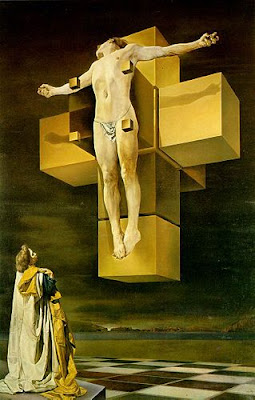 |
| Hypercube** Crucifixion, Salvador Dali Fair Use, Wikipedia |
Likewise also the chief priests mocking him, with the scribes and elders, said, He saved others; himself he cannot save. If he be the King of Israel, let him now come down from the cross, and we will believe.[emphasis added]--Matt 27:40-42 (KJV).
"Who his own self bare our sins in his own body on the tree, that we, being dead to sins, should live unto righteousness: by whose stripes ye were healed."--1 Peter 2:24"Faith is to believe what you do not see; the reward of this faith is to see what you believe."--St. Augustine
"Faith is the substance of things hoped for; the evidence of things not seen." --St. Paul
INTRODUCTION
It is late Palm Sunday, and I have listened to-- meditated on--the Passion according to St. Matthew, as I heard it in two Masses, a Vigil Mass and the 10:30 am Mass; in the latter I participated with our Church instrumental group (alto clarinet*). Both times the passage in the first quote struck me, and I wondered, what would have happened if, in fact, Jesus had come down from the Cross? I'll discuss below why Jesus didn't come down--there are two answers, one with which we Catholics are familiar and the other, perhaps not so much.
A SCIENCE-FICTION PRELUDE
In an early post, The Theology of Science Fiction I--Some SF Gospels, I argued that two science fiction stories in which Jesus was not crucified missed the point of His sacrifice and the theological implications. In one of these, Jesus argues with God in the Garden of Gethesmane that the Crucifixion is really not a rational way to show that God exists, so God lets Him be (or perhaps in this instance I should write "him"). In the other, Pilate heeds the advice of his wife who had a bad dream about Jesus and releases him (Him?); Jesus retires to Nazareth as an honored (but ignored) prophet, the Roman Emperor takes Judaism as the state religion and moves the Temple to Rome.
And so we are not saved, we live without the prospect of eternal life, because Jesus has not sacrificed Himself as satisfaction for our sins.
ANSELM'S SATISFACTION THEORY--JESUS TAKES ON OUR SINS
The Eucharistic Liturgy of the Mass is a Sacrifice, continued since the original sacrifice on the Cross. It is not a symbolic sacrifice, as some Christian sects would maintain. The Crucifixion is the sacrifice Jesus offered to save us from our sins, and is so indicated in many places in the New Testament and even in the Old.
Origen (184-253), in his "Ransom Theory", argued that Jesus gave his life as ransom to Satan to save us and those previously condemned to the nether world. This theory was disputed by St. Anselm, who proposed in his book Cur Deus Homo ("Why God Became Man") a "Satisfaction Theory". The quote below from the linked article ("Satisfaction Theory of the Atonement") gives the essence of that theory:
"Anslem believed that humans could not render to God more than what was due to him. The satisfaction due to God was greater than what all created beings are capable of doing, since they can only do what is already required of them. Therefore, God had to make satisfaction for himself. Yet if this satisfaction was going to avail for humans, it had to be made by a human. Therefore only a being that was both God and man could satisfy God and give him the honor that is due him." --TheopediaSo, Jesus could not come down from the Cross, because if he did, there would not be a sacrifice sufficient to atone for the sins of men.
NO EASY ROAD TO FAITH
After some reflection, I have come up with another reason that Jesus did not come down from the Cross. And that is the road to Faith should not be a super-highway, but a path that takes effort and will to travel--it should not be an easy journey. God could have put signs, "This rock was made by God", but doing that essentially denies our free will to make conscience based choices. The Priests and Sanhedrin indeed would have believed had He come down from the Cross, but then what? Would others not believe this was a mass hallucination and ignored it, as they did reports of His appearance after the Resurrection.?My own journey to faith was a rationally based, top-down experience (see Top Down to Jesus); no visions, no voices. It was based on a rational reading of historical accounts (the New Testament) and the insight that these accounts were true, so true that a group of unschooled fishermen and tax collectors gave their lives to spread the faith, and so true that their mission succeeded. Since the beginning of that journey it has deepened; I still have not heard a Voice or seen a Vision, but there have been times when I have known that God, Our Lord was present.
NOTES
*Whenever I play with the instrumental group I try to attend two Masses, since my attention sometimes focuses on the music rather than on the liturgy.
**A hypercube, a net of a tesseract, is a three-dimensional perspective of a four-dimensional cube. The painting represents, therefore, a two-dimensional perspective of a three-dimensional perspective.... See, for example, Robert Heinlein's famous sf story, "And He Built a Crooked House". I use this illustration, rather than the more well-known Medieval and Renaissance paintings of the Crucifixion, because it illustrates so well that the Crucifixion is a unique event, of this world and not of the world.
No comments:
Post a Comment